Working after hours
Here is a summary of the conditions for working outside normal opening hours :
After 8:00 PM (20:00)
In the weekends and holidays
- You need permission from your supervisor (Maxim)
- If working in the lab, there should be 2 persons around, who from time to time should check if the other person is still OK.
- You can work alone if you are only working in the office.
- A telephone must be present, so you can call the in-house emergency number 050-3638050 if needed
- Please use the bicycle basement for entering and leaving the building.
- Master students are only allowed after working hours, together with their PhD student. They can't get access permission to the building themselves
***
You have to report your presence by phone to the security personnel :
050-363 5520
***
- You have to do this when entering the building outside opening hours, or at 8:00 PM (20:00) if you want to continue to work (also office work).
- When leaving, you have to call them again to un-register yourself
[ this registration is needed for tracing people in possible evacuations etc ]
[ they need to know : your name, employee number, room number(s), name 2nd person if applicable ]
Full details can be found in the document : working-outside-of-opening-hours-fbg-oct-24.pdf.
This (official) document was issued by the Health, Safety & Environment department of our Faculty.
It can be found :
- Google drive\OCMP Team Drive\Working outside opening hours\
- https://myuniversity.rug.nl/infonet/medewerkers/fse/hse/building-safety/working-outside-of-opening-hours-fbg-oct-24.pdf
2023-11-01
PowerPoint slides of the Electricity and Magnetism course
[ PP-slide links are at the bottom of this page ]
Preface
I am pleased to share with you a comprehensive set of slides for the course "Electricity and Magnetism, Part II," which I had the privilege of teaching to first-year physics, applied physics and astronomy BSc students from 2017 to 2023. This course draws its foundation from the textbook "Introduction to Electrodynamics" by D.J. Griffiths (4th edition), focusing on Chapters 7 to 12. I am confident that these PowerPoint slides will prove to be a valuable resource not only for fellow educators but also for students and teaching assistants.
In several instances, I employed more in-depth derivations to tailor the course material to the needs of first-year students who may not yet have a strong grasp of mathematical concepts such as differential vector calculus, differential equations, and tensors. To ensure clarity and accessibility, I took a conceptual approach to explain the "why," "what," and "how" of each derivation before delving into the details. This step-by-step approach is designed to help students better understand and structure the material. Additionally, I adopted a notation with arrows above vector variables while maintaining the bold font. This choice aligns with our pedagogical approach, as it encourages students to clearly differentiate between scalars and vectors. By following this notation, I aimed to reinforce this important distinction throughout the course.
Furthermore, I incorporated animations into the slides, making them well-suited for online teaching, particularly during the COVID-19 lockdowns in 2020-21. These animations enhance the visual and interactive aspects of the presentation, making it easier for students to grasp complex concepts in an online learning environment.
The lecture slides closely adhere to the structure of Griffiths' chapters while simultaneously enriching the content with a diverse array of elements. These additions encompass historical insights, contemporary applications drawn from modern physics, captivating lecture demonstrations, multimedia resources like movies, and interactive lecture exercises. While the slides maintain alignment with Griffiths' chapters, they also offer a lecture-specific breakdown. This breakdown can be particularly valuable for instructors, as it aids in the thoughtful planning and organization of the course.
The inclusion of historical material aims to offer students a more comprehensive understanding of the pioneering scientists responsible for the development of electrodynamics and the underlying rationale guiding their breakthroughs.
The integration of examples from modern physics serves to establish direct links between classical electrodynamics and contemporary advancements in the field. For instance, phenomena such as laser tweezers, metamaterials, and free-electron lasers serve as illustrative instances of this connection.
Lecture demonstrations serve as a highly effective means of directly validating the theoretical concepts just covered through straightforward experiments conducted within the lecture hall. I owe a debt of gratitude to the physics lab team led by Dr. R.J.H. Klein-Douwel and Hans de Vries, who devised and prepared several of these demonstrations specifically for the lectures.
Movies were incorporated into the course on occasions when lecture demonstrations were either unavailable or as visual aids to elucidate various concepts discussed during the lectures.
The lecture exercises are designed to assess the students' comprehension and are presented in the form of two-minutes online polls. I actively encouraged students to engage in discussions with their peers to foster interactivity and self-directed learning. The lively exchange of ideas and the hum of conversations among students is precisely the kind of engagement every teacher aspires to hear in the lecture hall. I want to express my deep appreciation to Prof. A.M. van den Berg, whose valuable contributions were instrumental in developing many of these exercises.
Lastly, but certainly not least, I want to express my deep appreciation for the valuable collaboration with Prof. Steven Hoekstra. His dedicated coordination of the course for many years, as well as his contributions to Part I (Chapters 1-6), have been instrumental in the success of this course.
Feel free to access and utilize these slides, whether you are an instructor seeking supplementary materials or a student seeking a clearer grasp of the course content. Your feedback and suggestions for improvement are always welcome at
Maxim S. Pchenitchnikov (aka Pshenichnikov)
Faculty of Science and Engineering
University of Groningen
The Netherlands
1 November 2023
Please click on the links below to download the PowerPoint files :
Chapter 7. Electrodynamics.pptx
Chapter 8. Conservation laws.pptx
Chapter 9. Electromagnetic Waves.pptx
Chapter 10. Potentials and Fields.pptx
Chapter 12. Electrodynamics and Relativity.pptx
Research projects
In the OCMP group, we use optical spectroscopy to study a wide range of ultrafast phenomena in organic materials at nanoscopic lengths and femtosecond (0.000000000000001 s) time scale, with the main focus on exciton and charge dynamics in energy-related and bio-inspired materials, and molecular motors. To unveil the underlying molecular-level dynamics, we harness the fundamental interactions between light and matter through ultrafast spectroscopy. Our arsenal comprises a comprehensive array of both techniques such as time-resolved photoluminescence and transient absorption. Of particular interest to us is the innovative two-dimensional correlation spectroscopy (2D CS), a potent tool that extracts maximal insights into systems under consideration.
The key research goals in recent years have been the understanding of exciton and charge dynamics in energy-related materials such as molecular aggregates, crystals and monolayers, ultrafast dynamics of IR driven fluorescent molecular motors, and self-assembly of artificial light-harvesting complexes.
Exciton dynamics in artificial light-harvesting complexes
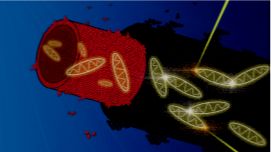 |
We have obtained (Nat. Comm. 2019; Phys.Chem.Chem.Phys. 2020; JACS 2020; Sci.Rep. 2022) a unifying picture of the exciton dynamics in artificial light-harvesting complexes, the so-called double-wall molecular nanotubes (DWNT). DWNTs appear to be remarkably robust against structural perturbations and able to adapt to different illumination conditions. We also made a first step towards understanding how supermolecular structure of DWNTs are self-assembled in aqueous environment (Sci. Rep. 2022, JACS 2023). We demonstrated that the self-assembly occurs in two stages: first, surface-adhered relatively small molecular structures are formed which are ordered internally but are disordered with respect to each other; and later, these structures rearrange to form the final well-ordered supramolecular double walled structure. This research is supported by NWO Open Competition Domain Science – KLEIN-2 (2020 – 2025) (together with Prof. Th.L.C.Jansen) |
Infrared-activated and photoluminescent molecular motors
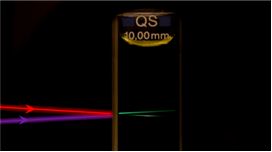 |
The great challenge for new generation of molecular motors is infrared light activation and making them fluorescent. With chemists from Prof. Feringa’s group, we have solved these issues (Science Advances 2020; Nat Comm 2022; Science Advances 2022). This opened up new possibilities for applications of molecular motors in biological settings and materials science with no harmful UV-blue light and possibility of tracking the motor’s location. |
Spectroscopy of new materials for organic solar cells
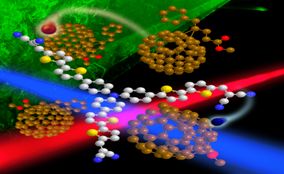 |
Organic photovoltaics (OPV) stands as a dynamic domain within the realm of organic electronics, demonstrating remarkable promise for diverse applications, such as wearable technology and seamless integration into various devices. These solar cells utilize organic semiconductors to harness the energy of sunlight and convert it into electricity. The photon-to-energy conversion process in organic solar cells is a multifaceted journey, marked by several pivotal stages, including exciton photogeneration, exciton diffusion, exciton dissociation, and of geminate charge recombination. These intricate processes occur at remarkably rapid timescales, spanning from femtoseconds to nanoseconds, and hold a direct sway over the overall efficiency and efficacy of these groundbreaking devices. Our goal is to tackle these processes by employing time-resolved ultrafast spectroscopy as a powerful tool. Some of our publications on the topic: Advanced Functional Materials 26, 2016; Adv. Opt. Materials 5, 2017, Organic electronics 53 2018; ACS Appl. Mater. Interface 11 2019; Science advances 5 2019; Chem. Eur. J. 26, 2020; Scientific Reports 10 2020; Phys. Chem. Chem. Phys. 23, 2021; Materials Today Energy 22, 2021; Phys. Chem. Chem. Phys. 24, 2022. This research is supported by “Spins for Efficient Photovoltaic Devices based on Organic Molecules” (SEPOMO) - Innovative Training Network (2016-2021) and “Efficient Fullerene-Free organic solar cells” (EIFFEL) Doctoral Networks (DN) HORIZON-MSCA-2022-DN-01-01 (2023-2027). |
Exciton diffusion in molecular crystals and monolayers
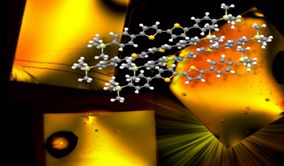 |
With our colleagues from Moscow State University (Prof. D.Yu. Paraschuk) and Russian Academy of Sciences (Prof. S.A. Ponomarenko), we introduced the concept of molecular self-doping in organic single crystals and monolayers (ACS Appl. Mater. Interfaces 9, 2017; Adv. Func. Materials 2018; J. Mater. Chem. C 2019, Mat. Chem. Frontiers 2023). This facilitated the enhancement of photoluminescence in the crystals and monolayers through the process of exciton diffusion to dopants. This research was supported by numerous Erasmus+ programme but had to be put on hold after February 24 2022. |
Currently taught courses by Maxim Pchenitchnikov
“Electricity and Magnetism I” (WBPH033-10)
https://ocasys.rug.nl/current/catalog/course/WBPH033-10
Lecture and tutorial course for 1st year BSc students
Departments of Physics/Applied Physics/Astronomy
“Electricity and Magnetism I&II” (WBPH033-10)
https://ocasys.rug.nl/current/catalog/course/WBPH033-10
Course coordinator
"Introduction to Nanophysics" (WBPH055-05)
https://ocasys.rug.nl/current/catalog/course/WBPH055-05)
lab excursion for 1st year BSc students (coordinator Prof. P. Rudolf)
“Fundamental properties of Nanomaterials and Devices: Optical Properties” (WMNS014-05)
https://ocasys.rug.nl/current/catalog/course/WMNS014-05)
lecture course for the “Top-Master in Nanoscience” MSc students (coordinator Dr dr. R.W.A. Havenith)
"Review paper: Searching, reading and writing scientific papers" (WMNS011-06)
https://ocasys.rug.nl/current/catalog/course/WMNS011-06)
lecture course for the “Top-Master in Nanoscience” MSc students (coordinator Prof. P. Onck)
"Ultrafast Time-Resolved Spectroscopy" (WMPH040-05 hl)
https://ocasys.rug.nl/current/catalog/course/WMPH040-05)
Lecture and practicum course for MSc students (together with Prof. Th.L.C.Jansen)
Dual-degree PhD-position in Ultrafast Spectroscopy on low-dimensional perovskites is available
Within the project “2D Spectroscopy of 2D Perovskites”, a PhD position is available at the Nanyang Technical University (NTU, Singapore) and University of Groningen (UG, the Netherlands),.
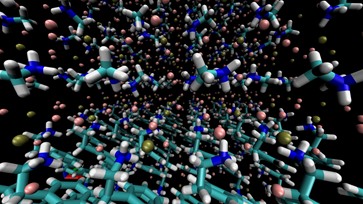
The aim of the project is to develop fundamental insight in performance of low-dimensional perovskites materials, with the main focus on two-dimensional (2D) correlation spectroscopy as the research tool. As such, the project implies strong collaboration between the groups of Femtosecond Dynamics Lab headed by Prof. Tze Chien Sum (Singapore) and the Optical Condensed Matter Physics group headed by Prof. Maxim Pshenichnikov (Groningen), when the activities and expertise of the both are cross-fertilized to reach the project goals.
The PhD student will gain experience in designing and manufacturing of the low-dimensional perovskites, and applying two-dimensional correlation spectroscopy to reveal their properties. The project is a result of collaborative agreements and a dual PhD programme signed between NTU and UG, highlighting the benefits of strong collaborations between the universities. Under the programme, the PhD candidate will be trained to do high-quality research in both NTU and UG and spend at least a year in the partner university. This will provide opportunities for the PhD student to participate in ground-breaking collaborative research and to learn from world-class groups at both universities, resulting in two PhD degrees, one from each university.
We offer
- PhD degrees from both universities
- Stimulating scientific environment with enthusiastic colleagues from both sides of the globe
- A number of training programs for additional education, supervision and soft academic skills
- A high degree of responsibility and independence, but also interactions and discussions with colleagues
- Exciting teaching opportunities
We require
- Strong motivation and enthusiasm as a researcher
- MSc degree in Physical Chemistry, Physics, Chemistry or equivalent
- Keen interest and strong skills in fundamental Physics/Spectroscopy
- Ability to be a team player who enjoys collaborating with international colleagues
- Fluency in English
Information and application
Please provide an application/motivation letter, emphasizing your specific interest and motivation to apply for this position, a detailed CV, contact details of at least 2 referees, academic transcripts of B.Sc. and M.Sc. education. An (online) interview will be part of the selection procedure.
Send the application package and further inquiries to:
Prof. Tze Chien Sum (
Background information
A research-intensive public university, Nanyang Technological University, Singapore (NTU Singapore) has 33,000 undergraduate and postgraduate students in the Engineering, Business, Science, Humanities, Arts, & Social Sciences, and Graduate colleges. Ranked 11th in the world, NTU has been placed the world’s top young university for the past six years. The University’s main campus is frequently listed among the Top 15 most beautiful university campuses in the world and it has 57 Green Mark-certified (equivalent to LEED-certified) building projects comprising more than 230 buildings, of which 95% are certified Green Mark Platinum.
The University of Groningen (UG) was founded in 1614, making it the oldest university in the Netherlands after Leiden. It is the 3rd largest university in the Netherlands, with over 33,500 students, 450 professors and 5000 employees. UG brought forward 2 Nobel Prize winners: Zernike (1953) and Feringa (2016). RUG is placed in the top 100 universities worldwide according to four international ranking tables. Groningen is a vibrant 1000-year old city in the North of The Netherlands. It combines a rich academic tradition with an attractive city life, characterized by culture, history, and an exciting social scene. Finally, you don’t need to speak Dutch – English will perfectly do!
